
- Homeowners
- Professionals
- Products
- Back
- PlasterBoards
- Metal Framing & Accessories
- Jointing and Finishing
- Gypsum Plasters
- Ceiling Tiles
By material Type
By Category
- Resources
- About
- Careers
- FAQ's
“Fires are a major hazard to human life and causes costly damage to the life and property.” Fire protection is the utmost priority in designing any type of building.
Fire safety in buildings is determined by a number of factors: the provisions of means of escape in case of fire, the ability for a building to resist the effects of fire and to minimize the spread of fire and smoke and the provision of means of access to enable firefighters to effect rescue and fight fire.
Thus, Saint Gobain Gyproc® with the help of its global presence and subject expertise, contribute in providing solution for Passive Fire protection in form of fire rated wall and ceiling systems, beam and column encasements etc. across all the segments adhering to the local code and standards.
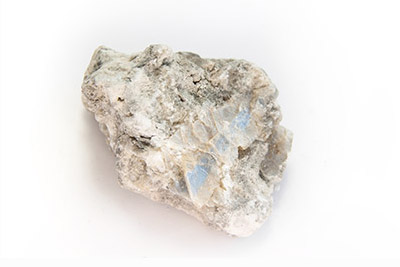
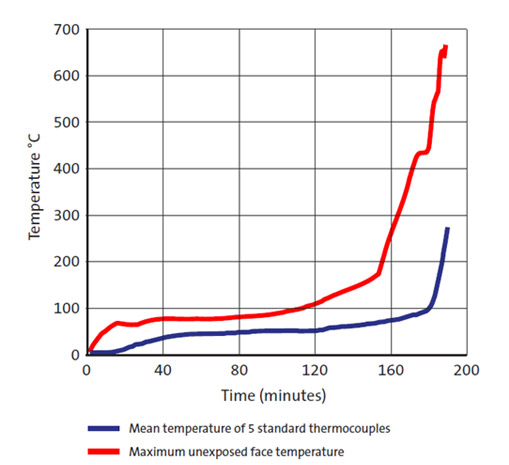
Temperature profile on the unexposed face . The graph shows that there is a large plateau in the temperature rise which is the period of time when the Fireline board is undergoing calcination. After this period the temperature gradually rises until the boards lose their integrity and fall away.
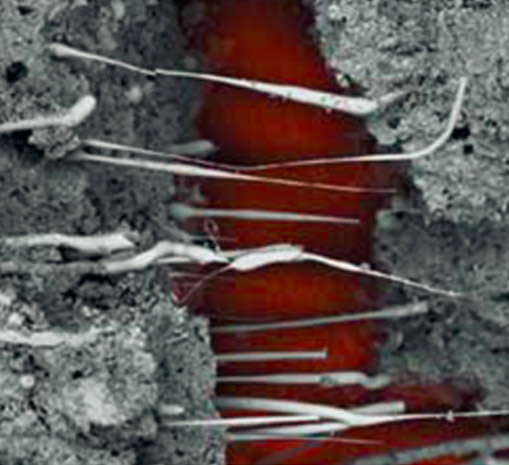
The inclusion of the glass fibre tissue and fire resistive additives within the gypsum core of Fireline Board improves the cohesive properties and fire integrity performance. This enables a much higher fire protection performance to be achieved compared to standard plasterboard. In terms of reaction to fire, Fireline Board is excellent performer as the endothermic hydration reaction requires energy to be taken from the fire, so in calorific terms gypsum is a negative contributor.
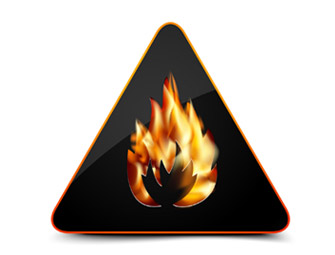
Oxygen
Heat
Fuel
The spread of the heat, smoke, and toxic gases is possibly the greatest single danger to life and takes place in much the same manner as does the spread of fire.
“Fire is a major hazard to human life and can cause costly damage to the life and property.”
No facility is absolutely fireproof. Nearly everything can burn, by given ignition, adequate fuel, and sufficient Oxygen.
CaSO4.2H2O(gypsum) is composed of 21% chemically combined water , 79% calcium sulphate, which is inert below a temperature of 12000C. Absorbs the heat and gradually releases water vapour Calcined gypsum formed on the exposed faces and further retards the hydration process, through the thickness of the board.
Additives Calcination starts at the surface exposed to the fire and then gradually through the gypsum layer. Addition of fiberglass, foaming agent, and other shrinkage inhibitors gives increased fire protection by limiting the board shrinkage and improving the integrity
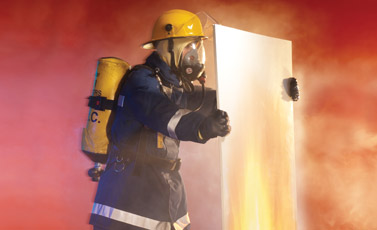
Fire protection within a building can be categorised into two different types:
“Involves actively detecting (smoke or fire) and suppressing once fire occurs”.
“It contains fires or slows the spread of fire through the use of fire rated walls, floors ,doors etc. for fire fighting activities to save lives and property”.
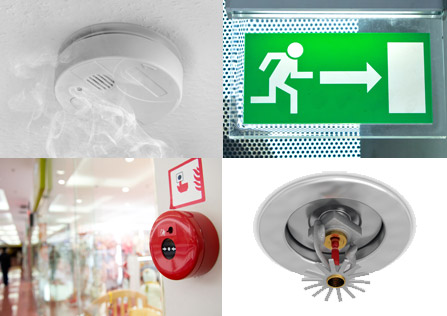
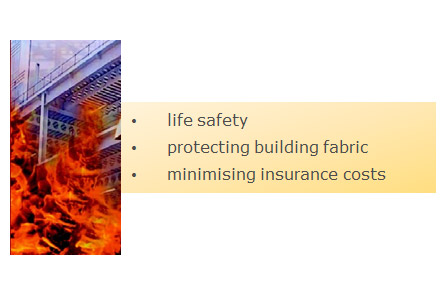
Structural fire precautions, as required by National Building Regulations, ensure that, for a reasonable period in the event of fire, the stability of a building is maintained and the spread of fire and smoke within a building and the spread of fire to and from other buildings is inhibited, allowing safe evacuation and fire fighting. Spread of fire within a building occurs as a result of fire exploiting any existing weaknesses or by burning through or conducting heat through the construction. Fire, smoke and hot gases can also spread throughout a building by various routes such as stairways, lifts, escalators, corridors, chutes, ducts and other cavities. Refer to Figure 1. The choice of building materials and how they are used to provide the required level of passive fire control depends on two factors - their ‘reaction to fire’ and their ‘fire resistance’.
All types of steel lose strength at temperatures above 300°C and eventually melt at about 1500°C. Importantly for design, the greatest rate of strength loss is in the range of 400°C to 600°C. The degree of protection required is determined by calculating the mass and surface area which helps establish the steel’s Heated Perimeter / Area factor or “Hp/A or Section factor”. The higher the Hp/A, the more the protection required to achieve the same fire rating; be it 30, 60, 90 ,120 minutes
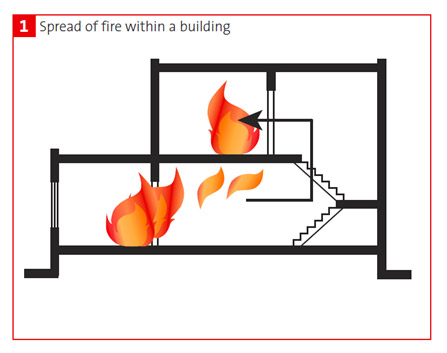

Compartmentation helps to prevent rapid fire spread within a building and/or to an adjoining building. By reducing the risk of a fire spreading, this helps the occupants evacuate and the fire service fight the fire, and limits disruption to business activities. The amount of compartmentation will vary according to the size and occupancy of the building.
Services should be formulated and constructed to minimize the contribution to fire growth or be protected from a fire condition. In most cases, building elements are imperforate when tested for fire resistance. However, in practice service routings and penetrations need to be accommodated. The suitability of building services, such as pipes or ducts, which pass through fire resistant constructions, need to be given serious consideration. Gaps and imperfections of fit will also need to be properly fire-stopped.
National Building Regulations and associated require elements of structure and other building elements to provide minimum periods of fire resistance, expressed in minutes, which are generally based on the occupancy and size of the building. Fire resistance is defined in BS 476: Part 20: 1987 as ‘the ability of an element of building construction to withstand exposure to a standard temperature / time and pressure regime without loss of its fire separating function or loadbearing function or both for a given time’. The tests criteria are :
A loadbearing element must support its test load. For floors, flat roofs and beams, allowable vertical deflection is limited to 1/20th of the clear span.
A separating element must resist collapse, the occurrence of holes, gaps or fissures through which flames and hot gases could pass and sustained flaming on the unexposed face.
A separating element must restrict the temperature rise of the unexposed face to below specified levels (maximum temperature rise of 180°C or average temperature rise on the standard five thermocouples of 140°C).
BS 476: Part 20: 1987
Describes the general procedures and equipment required
to determine the fire resistance of elements of construction.
BS 476: Part 21: 1987
Describes the specific equipment and procedures for
determining the fire resistance of loadbearing elements.
BS 476: Part 22: 1987
Describes the procedures for determining the fire resistance
of non-loadbearing elements.
BS 476: Part 23: 1987
Describes the specific equipment and procedures for
determining the contribution made by components to the
fire resistance of structures.
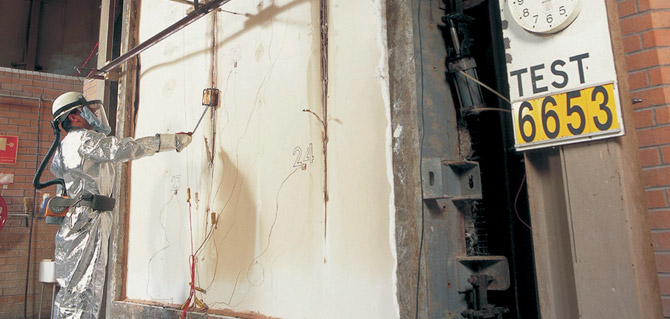
Reaction to fire tests can be performed to the following standards:
BS 476: Part 4: 1970 (1984)
Non-combustibility test for materials
BS 476: Part 6: 1989
Methods of test for fire propagation for fire products
BS 476: Part 7: 1997
Surface spread of flame tests for materials
BS 476: Part 11: 1982
Method of assessing the heat emission from building
materials
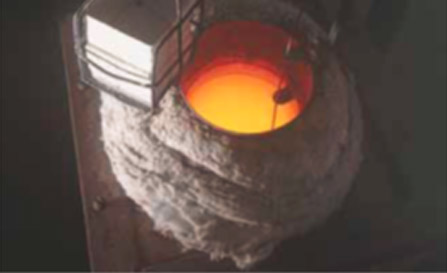
Non-Combustibility Test
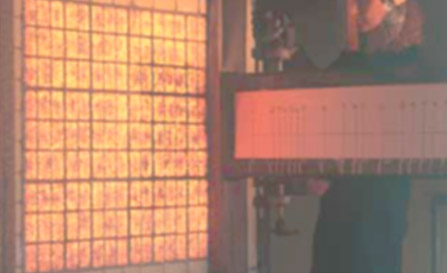
Surface spread of flame

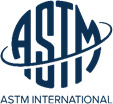

PFP attempts to contain fires or slow the spread, through use of fire-resistant walls, floors, and doors (amongst other examples).
Include Compartmentalization of the overall building through the use of Fire rated walls and floors. Organization into smaller fire compartments, consisting of one or more rooms or floors, prevents or slows the spread of fire from the room of fire origin to other building spaces, limiting building damage and providing more time to the building occupants for emergency evacuation or to reach an area of refuge.
To know more Pls download Fire solution Brochure.
Fire Rating or Fire Resistance rating is the period of time a building element, component or assembly maintains the ability to withstand fire exposure. It is determined by exposing the system to standard fire test maintaining standard time-temperature curve.
Gyproc provides fire rated systems for the following application;
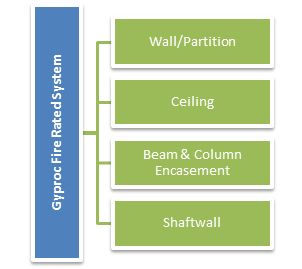
Yes, all the fire rated system are tested and certified by Govt. accredited and NABL recognized laboratories.
| For the Board | BS 476 Part 4,6,7,11, |

|
| For the Fire Rated System | BS 476 Part 20, 22,23,24 |
Fire Rated partition wall can be constructed upto 17meter height.
(Subject to site requirement and provisions)
Yes Gyproc® product , Pro roc FS is UL certified board. It is "TYPE C" Board. For more information kindly contact Gyproc representative.